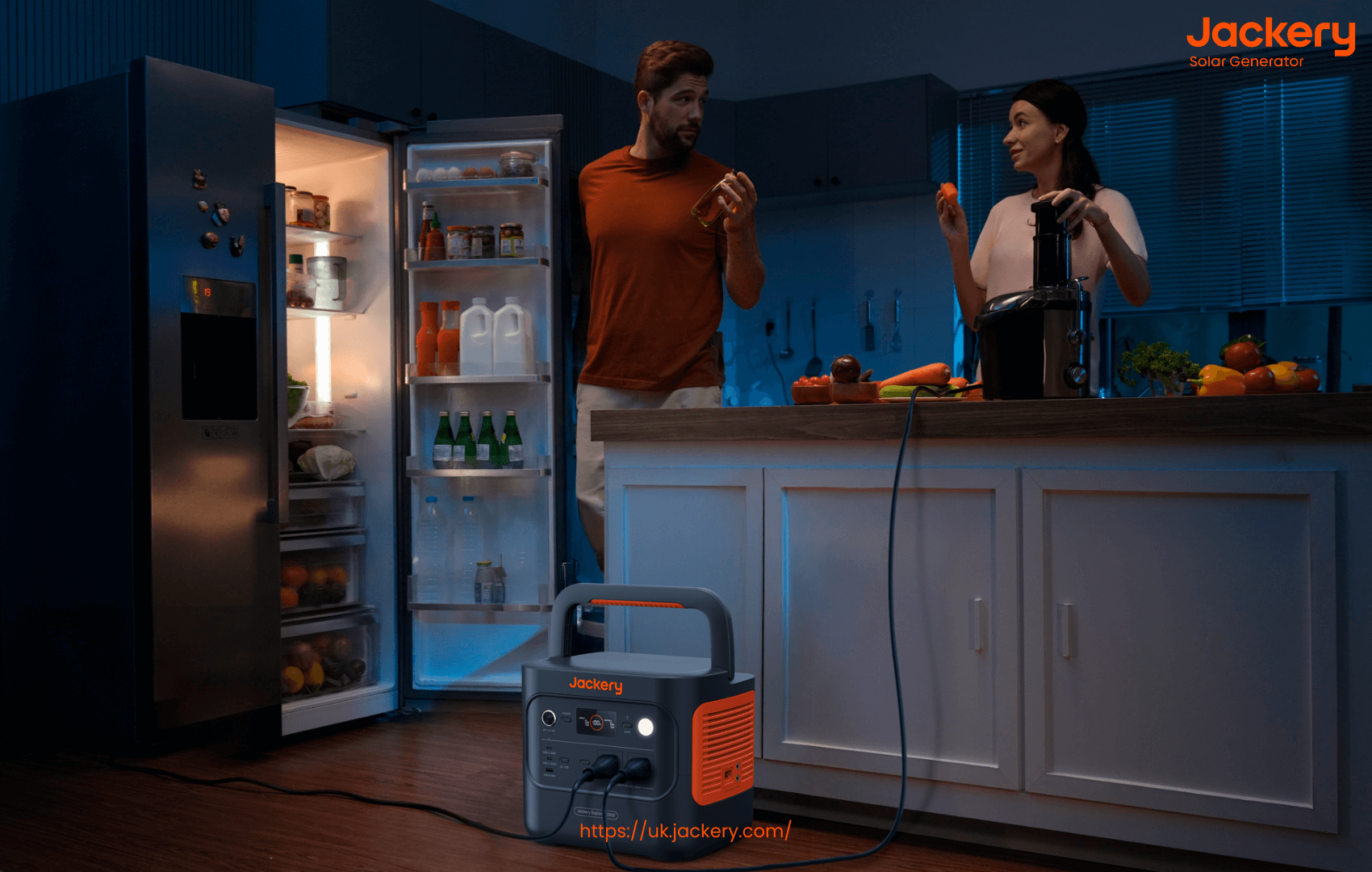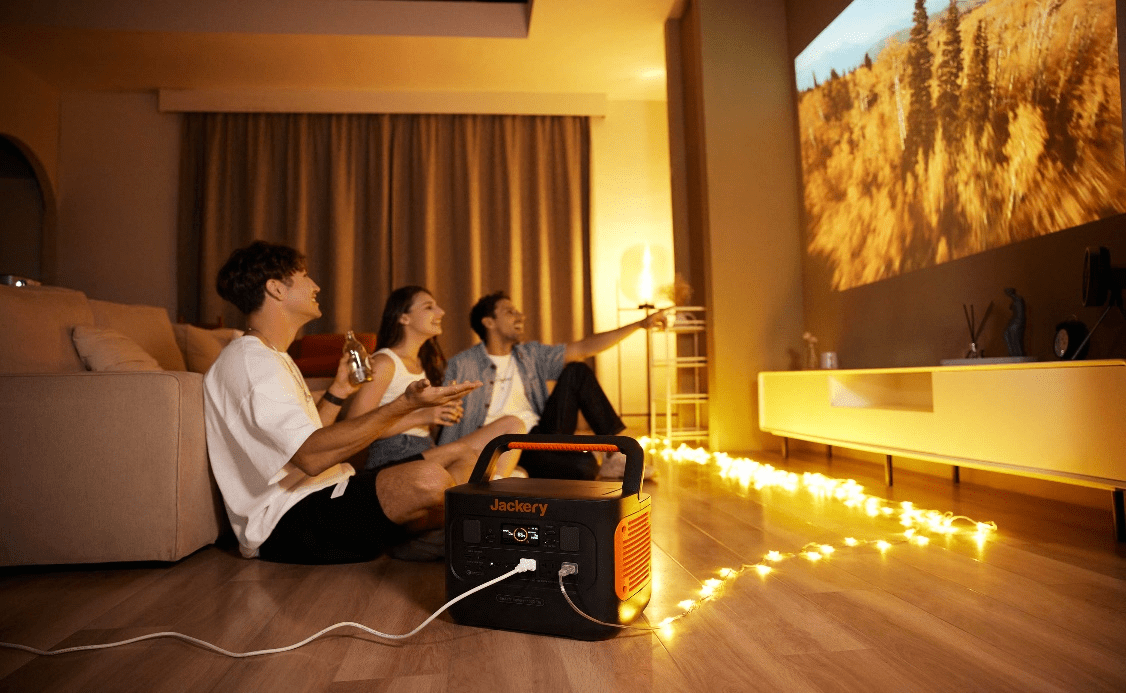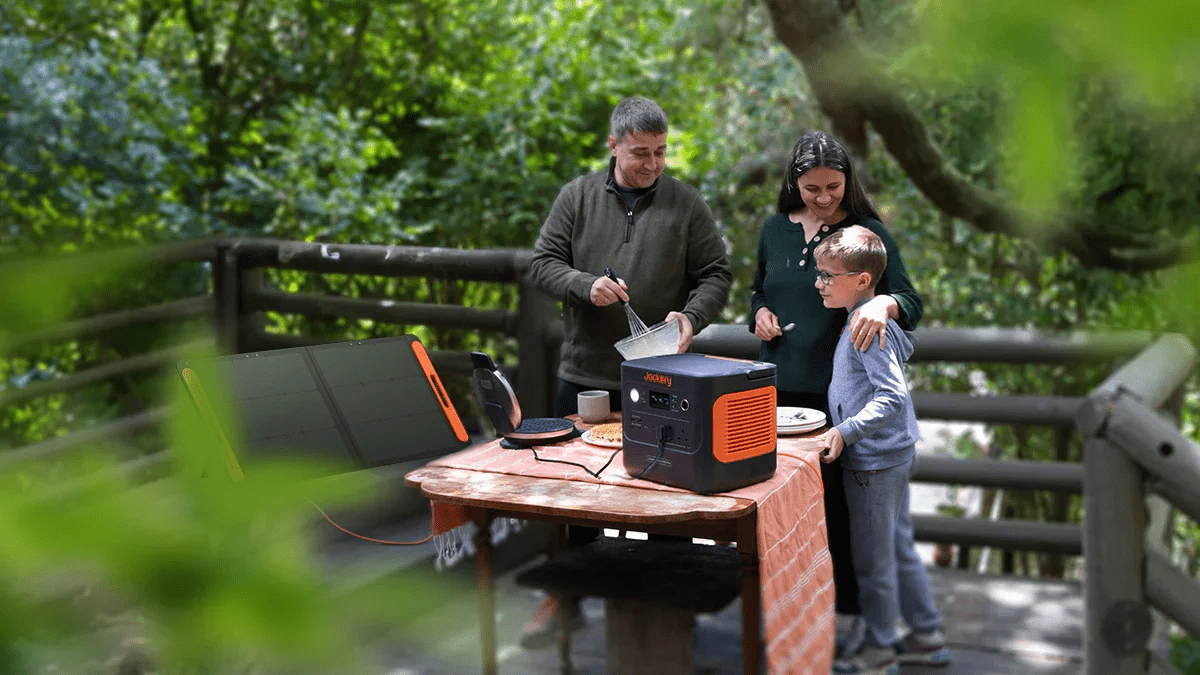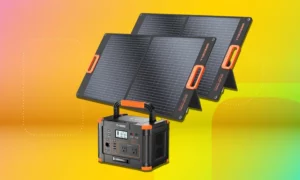Black Friday comes around and plenty of people start eyeing up a solar generator or portable power station in the sales. Then the doubts creep in — is winter really the right time to buy one? In a UK winter there are only around seven hours of daylight on average, with long, dark evenings. It’s easy to imagine a solar generator sitting in a cupboard until spring. But if you wait for warmer weather, you’re likely to miss the lowest prices of the year.
This guide looks at whether a solar generator is worth buying in winter, what you can realistically use it for, and how to choose the right setup so you’re not disappointed
Solar Generator vs Portable Power Station: What’s the Difference?
Once you start looking into backup power, you’ll keep coming across two terms: solar generator and portable power station. They sound as if they mean the same thing, but there is a difference.
A portable power station is essentially a large rechargeable battery in a box. You charge it from the mains or from a vehicle, then use it to power or charge other devices – laptops, phones, lights, routers, small appliances and so on. It doesn’t generate electricity itself; it simply stores and releases it.
A solar generator is a portable power station paired with solar panels. Together they work as a small off grid solar system: the battery stores energy, while the panels convert sunlight into electricity. You can charge from the mains when you like, but you also have the option to top up from the sun when you’re away from a socket. For people who camp, tour in a caravan or motorhome, spend time on a narrowboat or just want a quieter generator for home backup, that extra flexibility is often the main appeal.
Advantages of Solar Generators
A solar generator sits somewhere between a traditional fuel-powered portable generator and a simple battery. In a UK context, a few advantages stand out.
Quieter and cleaner than a fuel generator
A conventional portable generator usually runs on petrol or diesel, which means exhaust fumes, engine noise and regular servicing. A solar generator uses stored electricity and, when conditions allow, solar power. There are no exhaust gases while it’s running and noise levels are closer to a fan than an engine. That makes it much easier to live with in small gardens, shared outdoor spaces and campsites with quiet hours.
Flexible ways to charge
Most systems can be charged from a wall socket, a 12V car outlet or solar panels. For many people, that means charging overnight on a cheaper tariff, topping up in the car on a long drive, and using solar when parked up for a few days.
Multiple outputs in one compact unit
Compared with a basic battery pack, a solar generator or portable power station usually includes AC sockets, USB-A and USB-C ports and a 12V “car” outlet. The same unit can keep a router, some lights, a laptop, a phone and even a small appliance running at the same time. For many people it becomes a general-purpose portable generator that works as a camping generator at weekends and a quiet generator for home backup during power cuts.
Common Use Cases
Winter: home backup and bill smoothing
Once the clocks go back, the weather usually turns. Storms roll through more often, there’s more rain on the forecast and the odd cold snap can still bring snow or ice. Power cuts aren’t exactly rare, especially if you live near the coast or a bit out in the sticks. When the lights do go off, a solar generator is less about “going off-grid” and more about keeping normal life going – the Wi-Fi, a few lamps, the fridge or mini-fridge and, if you use one, a CPAP machine or other low-power medical kit.
If your heating controls rely on electricity, having a battery in the corner also means everything is less likely to stop at once. That’s the sort of backup that feels quietly reassuring in northern England, Scotland or more remote countryside, where it can take a while for an engineer to get out after a storm.
The shorter days don’t mean the system has to sit in a cupboard. Most units can also be charged from the mains or from a car, so you can top them up when it suits you and use the stored energy later. If you’re on a time-of-use tariff or have a smart meter, charging off-peak and drawing on the battery during the early-evening peak can take a little of the edge off energy bills.

Spring and summer: outdoor power and off-grid trips
Once the weather improves, the same setup moves outside quite naturally. A solar generator can follow you from basic campsites to glamping cabins, from a caravan pitch to a spot on the towpath, and then back into the garden at home for barbecues or film nights.
Plugging in a hob, coffee machine, portable speaker, projector or lighting turns a basic pitch into a much more comfortable space, without trailing extension leads back to the house.In this context, the system effectively becomes a camping generator – but without the noise and fumes of a petrol engine.
Creatives, remote workers and semi off-grid living
For photographers, videographers and remote workers, a solar generator can act as a small, quiet off grid solar system for work on the move. It can keep a laptop, camera batteries, drone chargers and a portable hotspot running in places where there are no sockets at all – whether that’s a cabin in the Highlands, a campervan in Wales or a rented cottage on the coast.
It also suits narrowboats, small rural cabins and garden offices that aren’t wired into the main house. You don’t necessarily need a permanent rooftop solar install; for some users, a portable power station and a couple of folding panels are enough to cover day-to-day essentials.
How to Choose a Solar Generator
Choosing the right size is mainly about matching the system to your own habits. Three things matter most: what you want to power, how many people are using it and how often you expect to rely on it.
It can help to ask yourself a few questions:
- Is it mainly for home backup, garden use, or regular camping and touring?
- Do you expect to run anything particularly power-hungry, like a kettle or induction hob?
- Is low weight more important, or are you willing to accept a heavier unit for longer runtimes?
- Do you have a balcony, patio or garden where you could set out solar panels?
Below is a simplified comparison of three Jackery v2 solar generator bundles, each pairing a portable power station with solar panels.
| Spec | Solar Generator 3000 v2 | Solar Generator 2000 v2 | Solar Generator 1000 v2 |
| Capacity | 3072 Wh | 2042 Wh | 1070 Wh |
| Continuous Output | 3600 W (7200 W surge) | 2200 W | 1500 W |
| AC Outlets | 3 × 230V ~ 13A (UK) | 2 × AC | 2 × AC |
| Battery Type | LiFePO₄ | LiFePO₄ | LiFePO₄ |
| Cycle Life (to 70%+) | 4000 cycles | 4000 cycles | 4000 cycles |
| Noise Level (Quiet Mode) | 27–30 dB | ≤30 dB | ≤22 dB |
| Fast Charging (AC+DC / Emergency) | 1.4 hours | 1.33 hours (emergency mode) | 1 hour (emergency mode) |
| Solar Charging Time | 3.5 hrs (1000 W) 22 hrs (1×200 W) |
5.5 hrs (400 W) | 15 hrs (1×100 W) |
| Weight | 27 kg | 17.5 kg (≈38.6 lbs) | 10.8 kg (≈23.8 lbs) |
| Smart Control | App control (smart modes included) | App control | App control |
| Warranty | 3+2 years | 3+2 years | 3+2 years |
*Approximate times in good sunlight with the recommended panel configuration.
Jackery Solar Generator 1000 v2 – a compact option for lighter use
If you mainly want something for occasional power cuts, or as a small camping generator for weekends away, the Solar Generator 1000 v2 is a sensible place to start. With 1070Wh of capacity and 1500W output (3000W surge), it can run typical low-to-medium loads such as:
- Wi-Fi router (10W): around 66 hours
- Small light (5W): over 150 hours
- Phone (around 29W while fast charging): 80+ charges
- Projector (100W): around 8 hours
- Portable fridge (60W): around 15 hours
At 10.8 kg, it’s the lightest of the three and easier to lift into a car or move around a flat. It’s well suited to solo campers, renters who want backup power in a small home, and anyone with limited storage space. For digital nomads, it works well as a quiet portable power station for laptops, phones, travel routers and camera batteries on shorter trips. In quiet mode, noise is around 22 dB, so it’s unlikely to disturb anyone in a campervan or shared indoor space.
Jackery Solar Generator 2000 v2 – a versatile main system
If two or more people are travelling together, or you want something that can act as a “main” generator for home backup and for trips, the Solar Generator 2000 v2 strikes a good balance. It provides 2042Wh of capacity and 2200W output (4400W surge), which is enough for a wider range of appliances:
- 800W kettle: roughly 10 boils
- 1120W coffee machine: around 1.8 hours of use
- 90W portable fridge: about 15 hours
- Laptop (around 80W while charging): roughly 19 charges
It supports up to 400W of solar input, with solar charging in roughly 5.5 hours in good conditions. For small families, couples who camp regularly or anyone wanting more headroom for both home and outdoor use, this size often feels the most flexible.

Jackery Solar Generator 3000 v2 – higher capacity for families and longer outages
For households with children, those living in more remote areas, or users who want a system that can cover longer outages and more demanding loads, the Solar Generator 3000 v2 offers a clear step up. It combines 3072Wh capacity with 3600W continuous output (7200W surge), which means it can sustain typical household appliances for useful periods:
- Fridge (around 200W): roughly 24–48 hours
- Electric oven (around 960W): around 2 hours
- Hair dryer (around 1200W): around 2.2 hours
Outside of emergencies, it’s also useful for family gatherings. A small garden party with speakers, decorative lighting, a projector and a drinks fridge is well within its comfort zone. For some users in rural properties, narrowboats or semi off-grid cabins, it becomes a central part of a more capable off-grid or hybrid setup.
A Solar Generator is Worth It
Buying a solar generator during Black Friday isn’t only about chasing a discount. For many households, it’s a way of adding a bit more control and resilience to their power use.
Quality systems are typically built around LiFePO₄ battery cells, with quoted lifespans of around 3000–4000 cycles to 70%+ remaining capacity. Used sensibly, that can equate to several years of regular use. Spread over that period, the cost per use is often lower than it appears at first.
With UK electricity prices having risen in recent years, and more time-of-use tariffs in circulation, there’s also more interest in when and how power is drawn from the grid. A solar generator gives you another option to:
- Shift some usage away from the most expensive hours
- Use more of your own solar when conditions allow
- Keep essentials running when there’s a local outage
Black Friday is simply the point in the year when many of these systems are offered at their lowest prices, sometimes with solar panels or accessories included in a bundle. It’s also not a purchase that only makes sense in summer. Winter is when it first proves its value – by providing backup during storms, acting as a buffer against peak prices and offering a quieter, cleaner alternative to a fuel portable generator. By spring and summer, the same unit naturally moves outdoors with you for camping, touring and evenings in the garden.For some families, it can even double as a practical winter or Christmas present: a shared piece of kit that offers everyday usefulness and a bit more peace of mind.

FAQs
Will a solar generator deteriorate if I don’t use it very often?
Quality units are designed to cope with long standby periods. Modern LiFePO₄ batteries have a relatively low self-discharge rate and can retain a high proportion of their charge over many months. For emergency use, it’s usually enough to check the battery every few months and top it up when needed. If your model has a storage or energy-saving mode, using that can help protect the battery further.
Is it always better to buy the largest capacity you can afford?
Not always. Larger units give you more runtime and higher output, but they’re also heavier, bulkier and more expensive. In practice, it’s often better to match the system to how you’ll use it:
- For occasional backup and short camping trips, a smaller, lighter model like the 1000 v2 is usually sufficient
- For regular outdoor use and small households running several devices, a mid-range system like the 2000 v2 is often more comfortable
- For rural homes, families with higher usage or semi off-grid setups, a higher-capacity system like the 3000 v2 makes more sense
Is there really enough sun in a UK winter for a solar generator to be useful?
Solar output is definitely lower in winter than in summer, but panels don’t stop generating altogether. In much of the UK there are still several hours of usable daylight, and panels can produce power under bright cloud as well as direct sun. More importantly, a solar generator can be charged from the mains or a vehicle, so it remains useful even on overcast days. Many users charge from the grid at cheaper times and treat the solar input as a bonus when the weather allows.
Final Thoughts
So, is a solar generator worth buying in winter? For many UK households, yes. Winter brings longer nights, a higher chance of outages and more pressure on energy bills. A portable power station won’t replace the grid, but it can keep the basics running and give you a bit more control over when you use electricity. With Black Friday offering the lowest prices of the year, it’s simply a sensible time to decide what sort of system fits your home or travel plans.
Take a look at the different setups and see which one fits your home or travel plans this winter.

































